Janet Chapple's Blog, page 8
May 4, 2017
Science Times tackles the complex Yellowstone wolf scene
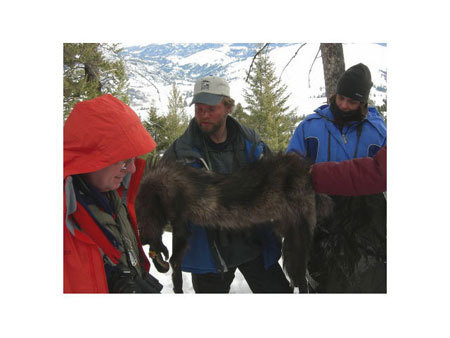 In this Tuesday’s “Science Times” section of the New York Times, freelance science writer Jim Robbins explains the push-pull between the lives of Yellowstone’s wolf packs (and the scientists who study them) and the needs and requirements of hunters and ranchers in the three surrounding states.
In this Tuesday’s “Science Times” section of the New York Times, freelance science writer Jim Robbins explains the push-pull between the lives of Yellowstone’s wolf packs (and the scientists who study them) and the needs and requirements of hunters and ranchers in the three surrounding states.
Since 2011 Montana and Idaho have been conducting managed wolf hunts, but in Wyoming a U.S. Court of Appeals has only this March approved a wolf-hunting plan that is deemed not to endanger the survival of the species in that state.
All the controversy about wolves stems from the 1995 and ’96 introduction of gray wolves (Canis lupus irremotus) into the park (and also into Idaho) from Alberta and British Columbia, Canada. Their population soared within a few years to around 150 wolves in the Greater Yellowstone Ecosystem, and scientists like Dr. Douglas Smith found, as quoted by Robbins, that “Yellowstone is the best place in the world to view wolves”—and to study them. This is especially true because the Yellowstone wolves do not fear the thousands of eager visitors who flock there—and incidentally add money to the regional economy. The wolves are thus quite readily visible.
In the years after the introduction of wolves, neighboring ranchers were understandably distressed. Some of their cattle, sheep, and even dogs were killed; before wolf hunting was authorized some ranchers were reimbursed by nonprofit organizations for their losses. It is hoped that protection within the park, combined with limited hunting outside its borders, will provide the needed balance and keep the population of Yellowstone’s wolves to approximately one hundred, as has happened in the last few years.
Robbins tells us much more about the results of research done by Smith and his colleagues. Longevity and social hierarchy within the packs are now better understood, and observation has revealed that wise older wolves serve an important role. Dr. Smith believes that packs are matrilineal. “Males come and go . . . but Gramma, Mom, and the daughter are the ones that stick around.” Here is a link to the whole article, “The New Threat to Wolves in and around Yellowstone.”
For some earlier blog posts about wolves here at YellowstoneTreasures.com, just enter “wolves” in the search bar.
Photo is of Yellowstone Forever Institute instructor Brad Bulin showing a wolf pelt, winter 2006. Photo by Janet Chapple.
April 21, 2017
News about Yellowstone opening weekend
I.
Today is the first day you can drive into the park from the North or East Entrance. What’s more, those of us stuck at home can now get predictions of the daytime eruptions of Old Faithful Geyser on the NPS website.
But, if you are anything like me, you are mostly celebrating that the time for your summer trip to this wonderful park is drawing nearer. Just one thing that may give us pause as we contemplate the sights we are anticipating seeing: the crowds are likely to be amazingly large.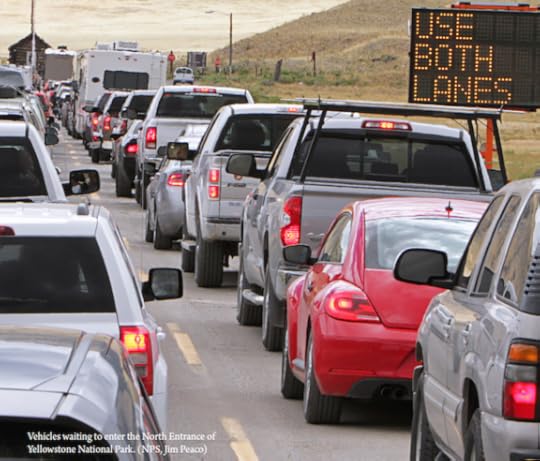
Here are links to a University of Montana report (2.7 MB pdf file) on 2016 crowding in that state’s two national parks and a shorter summary of the report, emphasizing Yellowstone, by Sean Reichard of YellowstoneInsider.com.
II.
If you should happen to be one of the people driving into Yellowstone this weekend, you may want to take part in tomorrow’s Earth Day Walk for Science at Old Faithful. This echoes the Washington, DC, Walk for Science. As an ever-curious non-scientist, if I lived anywhere near the park, I would certainly want to participate in that.
April 15, 2017
Trains to Yellowstone? Oh, for the days . . .
I just answered an amazing question on quora.com: “What are the dangers of taking a train to Yellowstone?”
To my mind this is a strange question, but perhaps the person asking it does not know where trains do and do not run in the U.S.
It would be great if there were still trains to one or more of the entrances to the park. However, the last passenger train—the Northern Pacific—to terminate at Gardiner, Montana (the North Entrance) arrived in the 1950s or ‘60s, and one could only get as far as Livingston on a train up to the 1970s. The other railroads that took passengers near the park had stopped running trains to the vicinity of Yellowstone even before that.
Your present options are taking a tour bus, flying to one of the gateway towns that has an airport and renting a car, or driving in your own car, which people do from every state in the Union.
Personally, I would think it high time that railroads reconsider the possibility of building tracks back to Gardiner, Cody, and/or West Yellowstone. The National Park Service should then set up shuttle buses to all the major points of interest—if only there were money for such a dream to come true any time soon. . . .
April 8, 2017
The Marvels of Yellowstone Lake
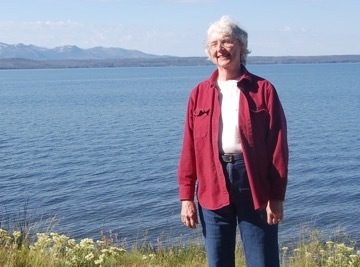
Janet on the north shore of the lake, 2009
While we recline in the doldrums awaiting the opening of Yellowstone Park’s roads—mostly on April 21st, when the bulk of the plowing should be done and wheeled vehicles can again reach the interior of the park—I will pass along a link about a man who is building a robot to learn what is below Yellowstone Lake and is yet to be discovered and explained by scientists. Elsewhere I learned that project leader David Lovalvo’s crowd sourcing for this project reached its goal of raising $100,000 last year.
Granted, this article appeared on the Internet quite a while ago, but its interest is evergreen. Geoscientists at the U.S. Geological Survey, particularly Lisa Morgan, Wayne Shanks, and Kenneth Pierce, published classic research papers on what they had learned by 2007*. But there is much more of interest lurking in the depths of the lake, and I only hope to live long enough to find out more about it.
*See the section titled “Yellowstone Lake Studies” in: Integrated Geoscience Studies in the Greater Yellowstone Area: U.S.G.S. Professional Paper 1717.
March 31, 2017
March 31st, the birthday of a Welsh painter of Yellowstone scenes
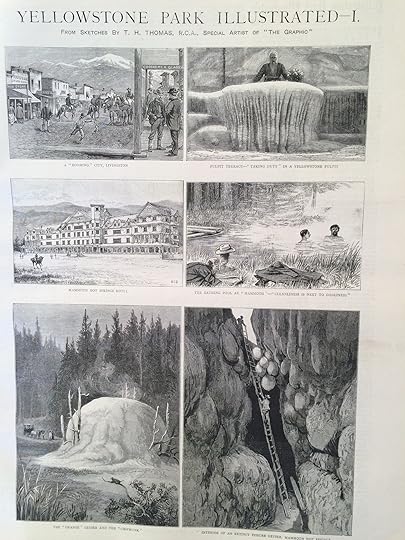 My iPhone shot shows a page from the August 11, 1888 Graphic. You see three scenes engraved from photographs: Livingston, Montana; Pulpit Terrace at Mammoth; and the Mammoth Hot Springs Hotel. One engraving is from a pencil sketch and two from watercolors: Bath Spring, Orange Spring Mound, and the interior of Devil’s Kitchen.
My iPhone shot shows a page from the August 11, 1888 Graphic. You see three scenes engraved from photographs: Livingston, Montana; Pulpit Terrace at Mammoth; and the Mammoth Hot Springs Hotel. One engraving is from a pencil sketch and two from watercolors: Bath Spring, Orange Spring Mound, and the interior of Devil’s Kitchen.
Today is the one-hundred-seventy-eighth birthday of Thomas Henry Thomas, the author and artist featured at the center of my 19th century collection, Through Early Yellowstone: Adventuring by Bicycle, Covered Wagon, Foot, Horseback, and Skis.
In 1884, you could travel around the new national park either by horseback or by horse-drawn coach. Thomas chose to ride. He wrote to a friend in his native Wales that he painted “quite half, if not more” of his watercolor sketches from “the logger-head of the Mexican saddle of my Cayuse.” In Through Early Yellowstone you can see 26 of his watercolors and one pencil sketch, none of which have ever been seen outside of Wales.
Born in 1839 in Pontypool, Wales, Thomas studied art at the British Royal Academy and also in France and Italy. His online biography does not tell us where he learned to write with his special combination of erudition, grace, and humor.
He spent most of his life in Cardiff, Wales, where he pursued many interests besides art, including archaeology, geology, and Welsh folklore. He served as artist to the London Graphic, a large-format publication with 16- by 12-inch pages. It took four years for the Graphic to turn some of Thomas’s Yellowstone watercolors and collected photographs into engravings. The first page of one of his two articles for the magazine is shown above.
Before Thomas died in his mid seventies in 1915, he bequeathed more than one thousand prints, drawings, and watercolors to the National Museum of Wales (Amgueddfa Cymru in Welsh), of which he was a founding father.
March 23, 2017
Through Early Yellowstone becomes a Foreword INDIES finalist
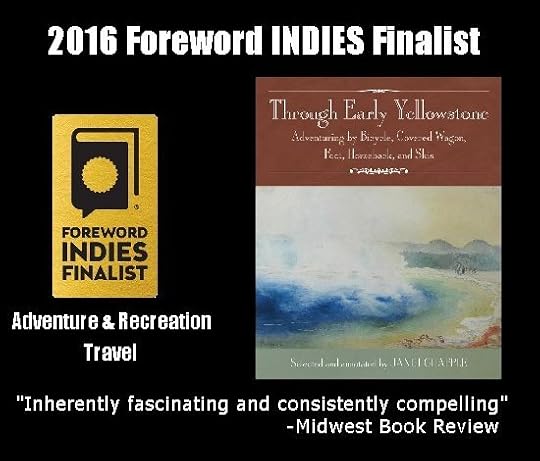
We’re celebrating at Granite Peak Publications since we learned that our historical anthology, published in 2016, has a good chance of winning top recognition for that year! Through Early Yellowstone: Adventuring by Bicycle, Covered Wagon, Foot, Horseback, and Skis is a finalist in two categories in this year’s contest run by Foreword Reviews, the foremost organization in helping promote outstanding independent press publications. The categories we entered are: Adventure & Recreation and Travel.
During the 21st century I have loved researching in libraries on both coasts and in Montana and Wyoming to locate the best early Yellowstone writings that need to be preserved in a modern book. By 2003 I had divided my findings into 11 categories, including early expeditions, the public entering the new park, early visits by various means, wildlife, poetry and songs, and other subjects. Wow! Even a sampling of the 85 articles I’d read and enjoyed by 2003 was way too much to fit into one collection.
Still, I kept reading. By 2007 I had read a great deal more but managed to pare my findings and categories down to a manageable number of articles and thought it was time to start seeking a publisher. Compiling what I was then calling Magnificent Playground required using my subjective judgment to reproduce the best written and most entertaining of these. In my letter to one university press, I acknowledged my awareness of two other Yellowstone historical anthologies, Old Yellowstone Days, edited by Paul Schullery, and Ho! for Wonderland, edited by park historian Lee Whittlesey and Betsy Watry. I intended to complement these two predecessor collections, not to compete with them. I wanted to avoid repeating descriptions of the many wonders of the park as much as possible, while giving readers a fascinating taste of early, long-out-of-print visitors’ accounts written by entertaining and talented writers and intrepid adventurers.
My editor/publisher/daughter Beth and I decided to publish the book with Granite Peak Publications, which up to that time had concentrated on putting out Yellowstone Treasures. Beth was particularly good at eliminating authors I had become enamored of but who did not fit well into the collection for our readers. I decided that we needed to include the short writings that I call snippets to show how the idea of an area that begged for preservation as the first national park gradually became a prime destination for travelers from all over the world.
The completion of the Northern Pacific Railroad (NPRR) across Montana in 1883 made access to the park much more convenient than before. A majority of the accounts in Through Early Yellowstone were written by people who used the NPRR and then traveled by horseback or horse-driven coach. Automobiles entered the park for the first time late in the 1915 season, and by 1917 they had taken over completely. It seemed to me the logical point for this anthology to end.
I am proudest of having found and been able to reproduce twenty-seven watercolor sketches, which (as the artist wrote to a friend) “are almost untouched travel sketches, quite half, if not more, of the Park ones being taken on the logger-head of the Mexican saddle of my Cayuse [Indian pony].” The artist, Thomas H. Thomas, visited from Wales in 1884. He wrote a delightful two-part article for a London magazine called The Graphic that turned many of his watercolors into engravings. In my book we reproduce many of the engravings along with his articles and roughly half-size reproductions of his watercolors. These reside in the archives of the National Museum of Wales and have never before been seen in this country.
—Janet
March 4, 2017
This Is When You Really Need “Yellowstone Treasures”

Mud Volcano area in winter. As of today Yellowstone is still covered in snow; most travel by car starts April 21, 2017.
March—while you may still be wishing for spring—is a great month to plan a summer or fall trip to Yellowstone. Here are some ways that Yellowstone Treasures can help you plan, especially if you haven’t been to the park before.First, if your time is going to be limited to two or three days, in the book’s introduction (pages 17 and 18) there’s a list of Best Sights. An enthusiastic Amazon.com customer last June wrote: “Ms. Chapple’s rating of one star for those sights that were ‘worth taking the time for,’ or two stars for those you ‘must see’ really helped us plan our two day stay. . . .” (But—if at all possible—I highly recommend that you stay a week or even more. You won’t regret it.)
Yellowstone has become so popular—with over 4.2 million visitors last year—that almost all the in-park cabin and hotel rooms are already booked. I have to blame this mostly on the large bus tours that book blocks of rooms a year or more ahead, knowing they can fill up their tours with no trouble. This leaves us individuals and families who plan later in the year with little recourse but to book rooms in gateway places like West Yellowstone, Moran, Cody, Cooke City, and Gardiner. You can, of course, book a space in campgrounds or in the only RV camping spot, if you are so inclined.
Fortunately, the gateway towns have lots of accommodations. You will find phone numbers and email addresses for the chambers of commerce of all the gateway towns in the back of YT, as well as how to contact the park concessionnaire, Xanterra (or Yellowstone Park Lodges). Also, see our Yellowstone Links for the chamber of commerce websites in those places. Online resources such as Booking.com can be a great help with finding rooms outside the park.
A chapter near the beginning of Yellowstone Treasures tells you all about the five different entrances to the park and what you’ll see on their approach roads. The bulk of the book (pages 38 to 301) is what you’ll use before you go, while you’re there, and for reference when you return home. It’s full of detailed maps made and kept up-to-date by my incomparable mapmaker, Linton A. Brown. Here is one from page 200 of the guidebook.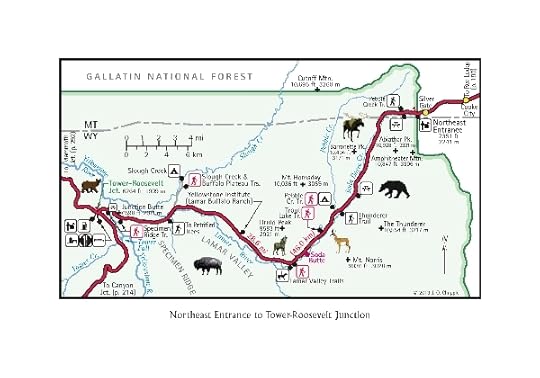
Happy planning!
Photo credit: Janet Chapple, 2012.
February 28, 2017
The 145th anniversary of Yellowstone Park
Yellowstone National Park was set aside as the world’s first national park 145 years ago, on March 1, 1872. An act of Congress on that date made sure that settlement and sale of the land was prevented, and set it apart “as a public park or pleasuring-ground for the benefit and enjoyment of the people.” We placed the text of this important document on page 50 of the Through Early Yellowstone anthology, along with stories by explorers, adventurers, and tourists. Let’s appreciate what our nineteenth-century lawmakers did for us!
February 21, 2017
Another way to share: Tumblr
In an effort to reach more people and explore the world, Granite Peak Publications is now on Tumblr in addition to Facebook and Twitter. Here’s our first post, sharing another picture from the historical anthology, Through Early Yellowstone (2016), which you can buy from this site or from an on-line or brick-and-mortar bookseller.
—Beth, Editor and Publisher
https://editorbeth.tumblr.com/post/157535481520/mammoth-hot-springs-focusin-on-cleopatra-springs
February 6, 2017
Search the book for your name or interest
Dear readers,
Did you know that Through Early Yellowstone describes a wide variety of people and places? You can now use the Look Inside feature on Amazon.com’s Through Early Yellowstone page to find just what all it covers. Among all the surnames of the writers collected in the anthology or people otherwise mentioned in the book may be your name or the name of someone you know or admire. Names you could look up include ones for just about every letter of the alphabet.
Allen
Baker
Corthell
Doane
Evermann
Folsom
Greene
Henderson
Ingersoll
Jordan
Kelly
Langford
Morris
Norris
Owen
Pomeroy
Queen’s Laundry (a hot spring, admittedly, but there’s a great watercolor sketch of it in the book!)
Roosevelt
Saunders
Thomas
Upper Falls (another geographical name . . . we share a picture from the book below)
Victor
Wilcox
X . . . (OK, now we’re stumped)
Yancey
Zip (nada for Z)
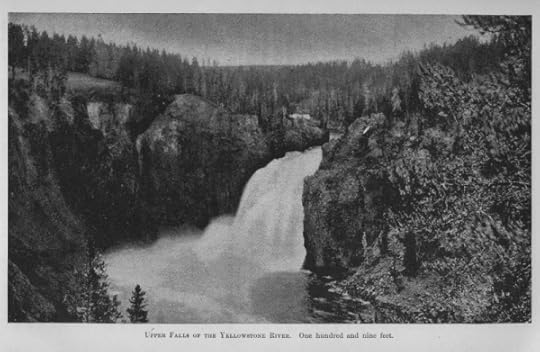
Upper Falls of the Yellowstone River
Image credit: Janet Chapple, Through Early Yellowstone: Adventuring by Bicycle, Covered Wagon, Foot, Horseback and Skis (Lake Forest Park, WA: Granite Peak Publications, 2016), 182. Originally published in Barton Warren Evermann, “Two-Ocean Pass” The Popular Science Monthly, 47 (June 1895): 175-87.
—Editor Beth




